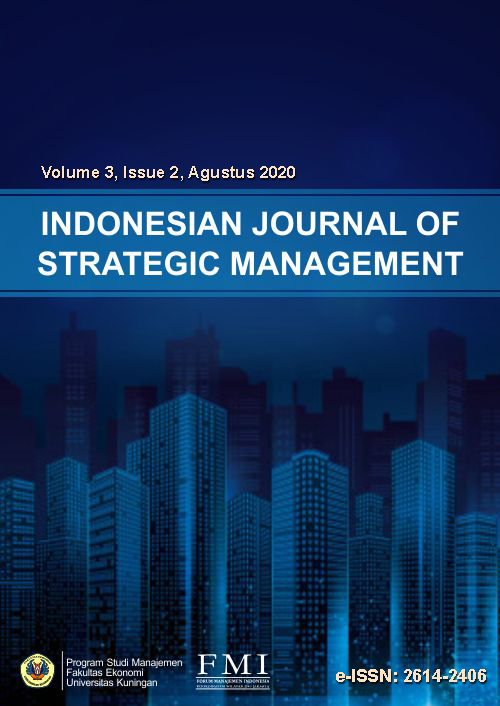ANALISIS PENGARUH INFLASI DAN PRODUK DOMESTIK BRUTO TERHADAP PROFITABILITAS
Abstrak
Abstract
The purpose of the present study is to explain the influence analysis of inflation, and Gross Domestic Product to the profitability (ROA) of islamic banking in Indonesia. Macroeconomic variables in this research are measured by inflation, and gross domestic product (GDP). The most important indicator in evaluating the banking financial performance is ROA. Sampling technique used here is purposive sampling, it is gained sample amount of 12 islamic banks.The data used in this study were obtained from published financial statements of ojk. Data analysis techniques used in this study is multiple linier regression analysis. t test results showed that partially, inflation and GDP has positive and significant influence on profitability (ROA). While the results of F test showed that simultaneous variable inflation, and GDP have a significant effect on profitability (ROA).
Keywords: inflation; Gross Domestic Product, Profitability, Return on Asset, Islamic Banking.
Abstrak
Tujuan dari penelitian ini adalah untuk menjelaskan analisis pengaruh inflasi, dan Produk Domestik Bruto terhadap profitabilitas (ROA) perbankan syariah di Indonesia. Variabel ekonomi makro dalam penelitian ini diukur dengan inflasi, dan produk domestik bruto (PDB). Indikator terpenting dalam mengevaluasi kinerja keuangan perbankan adalah ROA. Teknik pengambilan sampel yang digunakan adalah purposive sampling, diperoleh sampel sebanyak 12 bank syariah. Data yang digunakan dalam penelitian ini diperoleh dari laporan keuangan publikasi ojk. Teknik analisis data yang digunakan dalam penelitian ini adalah analisis regresi linier berganda. Hasil uji t menunjukkan bahwa secara parsial inflasi dan PDB berpengaruh positif dan signifikan terhadap profitabilitas (ROA). Sedangkan hasil uji F menunjukkan bahwa variabel simultan Inflasi, dan PDB berpengaruh signifikan terhadap Profitabilitas (ROA).
Kata Kunci: Inflasi; Produk Domestik Bruto, Profitabilitas, Return on Asset, Perbankan Syariah.
Referensi
DAFTAR PUSTAKA
Akhtar M, Ali K and Sadaqat S (2011) Factors Influencing the Profitability of Islamic Banks of Pakistan. International Research Journal of Finance and Economics 66(66): 1–8. Available from: http://joc.hcc.edu.pk/faculty_publications/IRJFE_66_12.pdf.
Ali, Khizer. et.al. 2011. Bank-Specific and Macroeconomic Indicators of Profitability – Empirical Evidence from the Commercial Banks of Pakistan. International Journal of Business and Social Science, (Online), Vol. 2, No. 6.
Alharbi AT (2015) Determinants of Islamic banks profitability : international evidence. International Journal of Islamic and Middle Eastern Finance and Management: 1–21.
Bashir AH (2003) Determinants of profitability in Islamic banks : Some evidence from the Middle East. Islamic Economic Studies 11(1): 32–57.
Belanes, Amel. “Islamic versus Conventional Banks : A Comparative Analysis on Capital Structure.” Afro-Asian Journal Finance and Accounting, vol. 5, no. 3, 2015, pp. 248–264, doi:10.1504/AAJFA.2015.070292.
Boediono. 1990. Ekonomi Moneter. Yogyakarta:BPFE.
Chowdhury MAF, Haque MM and Masih M (2017) Re-Examining the Determinants of Islamic Bank Performance: New Evidence from Dynamic GMM, Quantile Regression, and Wavelet Coherence Approaches. Emerging Markets Finance and Trade 53(7): 1519–1534.
Eldomiaty, Tarek I. Determinants of Corporate Capital Structure : Evidence from an Emerging Economy. Vol. 17, no. 1, 2007, pp.25–43, doi:10.1108/10569210710774730.
Khediri K Ben and Khedhiri H Ben (2009) Determinants of Islamic bank profitability in the MENA region. International Journal of Monetary Economics and Finance 2(3/4): 409–426.
Masood O and Ashraf M (2012) Bank‐specific and macroeconomic profitability determinants of Islamic banks. Qualitative Research in Financial Markets 4(2/3): 255–268. Available from: http://www.emeraldinsight.com/doi/10.1108/17554171211252565.
OJK (2016) The Sharia Indonesia Banking Statistic. Jakarta.
Tan Y (2016) The impacts of risk and competition on bank profitability in China. Journal of International Financial Markets, Institutions and Money, Elsevier B.V. 40: 85–110. Available from: http://dx.doi.org/10.1016/j.intfin.2015.09.003.
Tarek Al-Kayed, Lama, et al. “The Relationship between Capital Structure and Performance of Islamic Banks.” Journal of Islamic Accounting and Business Research, vol. 5, no. 2, 2014, pp. 158–181, doi:10.1108/JIABR-04-2012-0024.
Toumi, Kaouther, et al. “Alternative Financial Decision Principles: Theoretical Foundations of Islamic Banks’ Capital Structure.” Recent Developments in Alternative Finance:Empirical Assessments and Economic Implications, vol. 22, no. 2012, 2015, pp. 157–172, doi:10.1108/S1571-0386(2012)0000022013.
Said M and Ali H (2016) An analysis on the factors affecting profitability level of Sharia banking in Indonesia. Banks and Bank Systems 11(3): 28–36. Available from: http://businessperspectives.org/component/option,com_journals/task,preview/jid,6/id,337/.
Sahara AY (2013) Analisis Pengaruh Inflasi, Suku Bunga BI, dan Produk Domestik Bruto terhadap Return On Asset (ROA) Bank Syariah di Indonesia. Jurnal Ilmu Manajemen 1(1): 149–157.
Sukirno, Sadono. 2003. Teori Pengantar Ekonomi Makro. Jakarta: PT. Raja Grafindo
Persada.
Zarrouk H, Jedidia K Ben and Moualhi M (2016) Is Islamic bank profitability driven by same forces as conventional banks ? International Journal of Islamic and Middle Eastern Finance and Management 9(1): 46–65.

